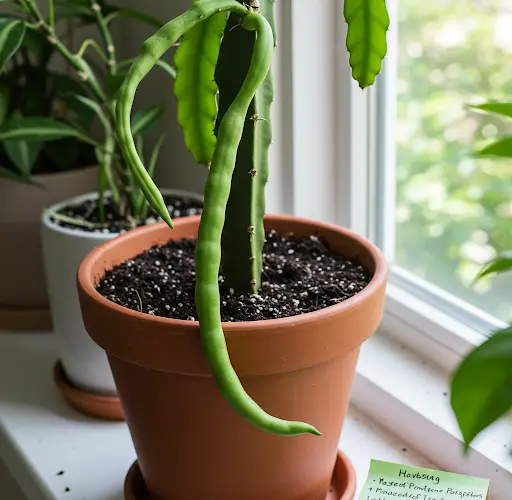How to Grow Dragon Beans at Home: A Complete Guide
If you’re looking to add an exotic and nutrient-rich vegetable to your home garden, dragon beans (also known as winged beans or Goa beans) are a fantastic option. These unique legumes are not only beautiful to look at, with their winged edges and vibrant green pods, but they’re also packed with protein, vitamins, and minerals.
Even better, dragon beans can be grown right at home—even in small spaces—with the right care and setup. This guide walks you through everything you need to know to successfully grow dragon beans at home, whether you’re working with a garden bed, balcony container, or rooftop setup.
What Are Dragon Beans?
Dragon beans (Psophocarpus tetragonolobus) are climbing legumes native to Southeast Asia. They’re known for their unique four-angled pods that resemble wings, giving them the nickname “winged beans.” Nearly every part of the plant is edible, including the pods, leaves, shoots, flowers, and even the tubers.
They thrive in warm, humid climates and produce abundant yields when grown with proper sunlight and support. Their climbing vines make them a great crop for vertical gardening, ideal for maximizing space.
Why Grow Dragon Beans at Home?
Here are a few reasons to start growing dragon beans:
-
Highly nutritious – Rich in protein, fiber, calcium, and iron.
-
Versatile in cooking – Pods can be steamed, sautéed, stir-fried, or added to soups.
-
Minimal waste – Almost the entire plant is edible.
-
Excellent for small spaces – Grows vertically and doesn’t require a large plot.
-
Attractive foliage and flowers – Adds beauty to your space in addition to food.
What You’ll Need
To get started with growing dragon beans at home, gather the following materials:
-
Dragon bean seeds
-
Seed-starting trays or small pots (for germination)
-
Large containers or garden beds (at least 12 inches deep)
-
Trellis, stakes, or netting for support
-
Rich, well-draining soil
-
Compost or organic fertilizer
-
Access to full sun (6–8 hours per day)
Step-by-Step Growing Instructions
Step 1: Soak and Germinate the Seeds
Dragon bean seeds have a hard outer shell, so soaking them in warm water for 12–24 hours before planting helps speed up germination. After soaking, sow the seeds in seed-starting trays or directly in small pots with moist potting mix.
Place the trays in a warm, sunny location. Germination usually takes 7–10 days.
Step 2: Transplant Seedlings
Once the seedlings have developed 2–3 sets of true leaves and are about 4–6 inches tall, they’re ready to be transplanted into their final growing space. Choose a large container, raised bed, or garden plot with rich, loose soil.
If you’re planting in containers, make sure each one is at least 12 inches deep and wide to allow ample root growth. Mix compost into the soil before transplanting to give the plants a nutrient boost.
Step 3: Provide a Climbing Support
Dragon beans are vigorous climbers and need vertical support to grow properly. Set up a sturdy trellis, bamboo stakes, or garden netting next to each planting area.
Train the vines to climb as they grow by gently tying them with soft garden ties or string. Vertical growing helps improve air circulation and makes harvesting easier.
Step 4: Watering and Feeding
Keep the soil evenly moist, especially during flowering and pod development. Avoid waterlogging the soil, as dragon beans don’t like soggy roots.
Feed the plants with a balanced organic fertilizer or compost tea every two weeks. Once they start flowering, a phosphorus-rich fertilizer can help encourage more blooms and pods.
Harvesting Dragon Beans
Dragon beans grow fast, and you can begin harvesting within 60–75 days after planting. Pick the pods when they are about 6–8 inches long and still tender. Older pods become tough and fibrous, so regular harvesting encourages the plant to keep producing.
Use scissors or garden shears to cut the pods from the vine. You can also harvest the leaves and young shoots for stir-fries and soups.
Growing Tips for Better Yields
-
Grow in warm seasons – Dragon beans thrive in warm, humid weather. In cooler climates, start them indoors early or grow during peak summer.
-
Rotate crops – Don’t plant dragon beans in the same spot each year to prevent soil-borne diseases.
-
Add mulch – Mulching helps retain moisture and keeps the roots cool.
-
Watch for pests – Look out for aphids or caterpillars and treat early with neem oil or an organic insecticidal soap.
Final Thoughts
Growing dragon beans at home is not only easy and rewarding, but it’s also a great way to diversify your homegrown vegetables. These climbing, nutrient-rich plants provide abundant harvests in even the smallest of spaces and bring a tropical flair to your garden or balcony.
With just a bit of care, you’ll be harvesting fresh dragon beans right from your home—ready to toss into your favorite dishes, stir-fries, and more.



